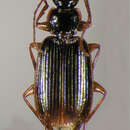Pinacodera platicollis: Brief Summary
provided by wikipedia EN
Pinacodera platicollis is a species in the beetle family Carabidae. It is found in the United States and Canada.
- license
- cc-by-sa-3.0
- copyright
- Wikipedia authors and editors
Description
provided by Zookeys
OBL 8.17 – 11.67 mm.
Color. Dorsum of head brunneous or rufous to rufo-piceous; dorsum of pronotum and elytra brunneous or rufous to rufo-piceous with pale, somewhat translucent margins; antennae rufo-testaceous to brunneous; palpi rufo-testaceous to brunneous; epipleura testaceous to rufo-testaceous; lateral and ventral thoracic sclerites and abdominal sterna testaceous to piceous.
Microsculpture. Individuals with microlines not visible (or hardly so) on dorsum of head capsule and pronotum at 50× magnification. Elytra with mesh pattern isodiametric, microlines clearly defined.
Macrosculpture and pilosity. Head capsule dorsally with very fine to coarse scattered setigerous punctures on dorsal surface from constriction of neck extended anteriorly toward clypeus, ventrally with scattered pilose punctures laterally, extended from constriction of neck to gula. Pronotum with shallow to somewhat deep and randomly spaced setigerous punctures, setal length very short to moderate at 50×; ventrally with randomly spaced setigerous punctures extended from margin of proepipleuron to apex of intercoxal process; setae visible on prosternum but not proepisterna. Elytra with striae shallowly to moderately deeply impressed, punctulate throughout length; intervals flat to slightly convex; few specimens with odd intervals somewhat raised and even intervals flat. Other details in “Variation” section below.
Fixed setae. Pronotum with two setae along each lateral margin. Elytra with 14–16 lateral (umbilical) setae;two setae on each of abdominal sterna III to VI; four setae along apical margin of sternum VII (Fig. 3).
Luster. Elytra glossy.
Pronotum. (Fig. 19B) Anterior and posterior impression shallow; median longitudinal impression moderately shallow; posteriolateral angles widely obtuse (approaching round); posterior margin slightly lobate.
Head. Eyes, labrum, labium, and palpi, typical for Cymindidina.
Elytra. Humeri broadly rounded; striae shallowly to moderately impressed; lateral margin smooth, rounded and widened preapically; elytral apices subtruncate (Fig. 12, 16).
Hind wings. Macropterous.
Legs. Males with adhesive vestiture ventrally, two rows of squamo- setae on tarsomeres 1–4 of foreleg and 1–3 of middle leg.
Male genitalia (Fig. 14A, 20A). Endophallus with ventral surface slightly curved. Ventral and dorsal surface of apical area somewhat to markedly dimpled in appearance (Fig. 15A-B). Endophallus with a slightly curved endophallic plate (ep) apically (Lindroth 1969: 1080–1081), when viewed ventrally in everted condition (Fig. 14A).
Female genitalia. Gonocoxite 2 (gc2) (Fig. 14B) moderately long and narrow, slightly to moderately curved outwards. Internal genitalia with long cylindrical spermatheca (sp), moderately long associated spermathecal gland (sg), and moderately long spermathecal diverticulum (sd) located at base of spermathecal gland duct (sgd).
- license
- cc-by-3.0
- copyright
- Wesley M. Hunting
- bibliographic citation
- Hunting W (2013) A taxonomic revision of the Cymindis (Pinacodera) limbata species group (Coleoptera, Carabidae, Lebiini), including description of a new species from Florida, U.S.A. ZooKeys 259: 1–73
- author
- Wesley M. Hunting

